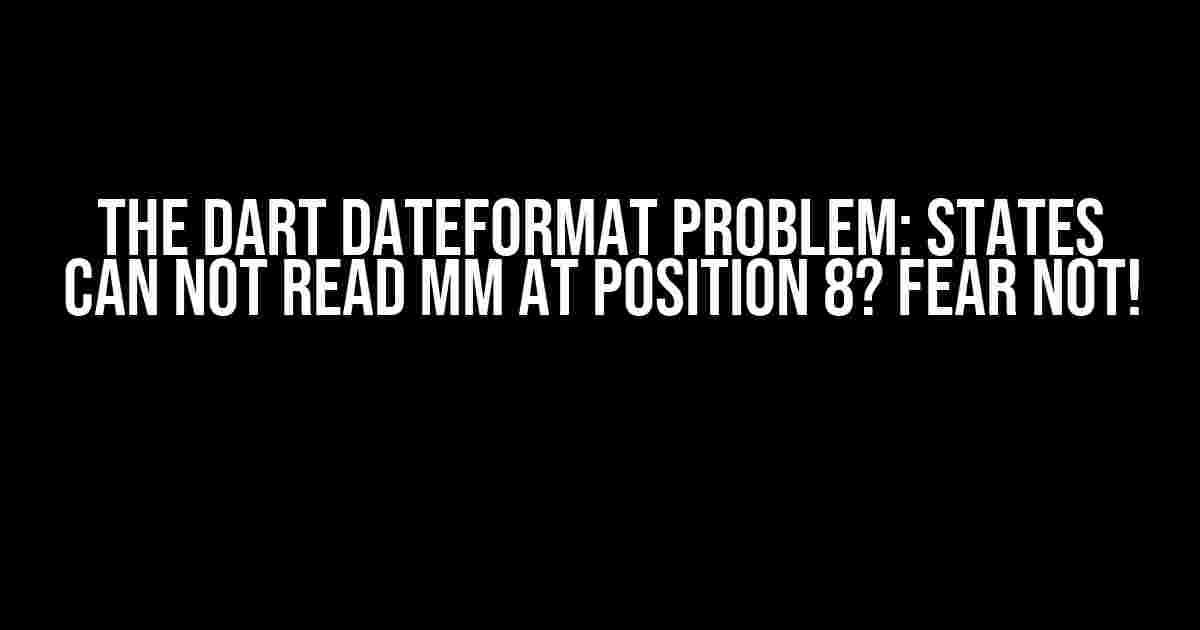Are you tired of wrestling with the pesky Dart DateFormat issue that refuses to read MM at position 8? Well, put down those boxing gloves and take a deep breath, because we’ve got the solution right here! In this article, we’ll dive into the depths of this problem, explore its causes, and provide you with step-by-step instructions to overcome this hurdle.
What is the Dart DateFormat Problem?
The Dart DateFormat problem occurs when you’re trying to parse a date string using the DateFormat class in Dart, but it throws an exception because it can’t read the MM (month) at position 8. This can be frustrating, especially when you’re working on a critical project and need to get this working ASAP!
Why Does This Problem Occur?
So, why does this problem occur in the first place? Well, it’s because the DateFormat class in Dart is quite picky about the format of the date string it’s trying to parse. If the format doesn’t match the expected pattern, it will throw an exception.
Here’s an example of a date string that might cause this problem:
String dateString = "2022-02-28 14:30:00";
In this example, the month is represented by “02”, which is a valid format. However, when you try to parse this string using the DateFormat class, it might throw an exception because it can’t read the MM at position 8.
Solving the Dart DateFormat Problem
Now that we’ve diagnosed the problem, let’s get to the solution! To fix this issue, you need to create a DateFormat object with the correct pattern, and then use it to parse the date string. Here’s an example:
import 'package:intl/intl.dart';
void main() {
String dateString = "2022-02-28 14:30:00";
DateFormat dateFormat = DateFormat("yyyy-MM-dd HH:mm:ss"); // Set the correct pattern
DateTime date = dateFormat.parse(dateString); // Parse the date string
print(date); // Output: 2022-02-28 14:30:00.000
}
In this example, we created a DateFormat object with the pattern “yyyy-MM-dd HH:mm:ss”, which matches the format of our date string. We then used this object to parse the date string, and voilà! We got the correct DateTime object.
Common DateFormat Patterns
Here are some common DateFormat patterns that you might find useful:
| Pattern | Description |
|---|---|
| yyyy | 4-digit year |
| MM | 2-digit month (01-12) |
| dd | 2-digit day (01-31) |
| HH | 2-digit hour (00-23) |
| 2-digit minute (00-59) | |
| 2-digit second (00-59) |
You can combine these patterns to create a DateFormat object that matches your specific needs.
Troubleshooting Tips
Here are some troubleshooting tips to help you overcome the Dart DateFormat problem:
- Make sure the date string matches the format of the DateFormat object.
- Check for typos in the date string or the DateFormat pattern.
- Verify that the date string is not null or empty.
- Use the correct locale when creating the DateFormat object (e.g., en_US, fr_FR, etc.).
- If you’re working with a JSON or XML response, make sure the date string is properly deserialized.
Conclusion
And there you have it! With these instructions and troubleshooting tips, you should be able to overcome the Dart DateFormat problem and successfully parse your date strings. Remember to always double-check the format of your date string and the DateFormat pattern, and don’t hesitate to experiment with different patterns until you find the one that works for you.
So, the next time you encounter the dreaded “states can not read MM at position 8” error, you’ll know exactly what to do. Happy coding!
Keywords: Dart DateFormat problem, states can not read MM at position 8, parsing date strings, DateFormat class, Dart programming language.
Frequently Asked Question
Having trouble with Dart DateFormat? Let’s get to the bottom of it!
Q: Why does my Dart DateFormat throw an error when trying to parse a date string with ‘MM’ at position 8?
A: This issue arises because ‘MM’ is used to represent minutes, not months. You should use ‘MM’ at the correct position in your date format string, or use ‘MMM’ or ‘MMMM’ for month names. Ensure your format string accurately reflects the input date string.
Q: Can I use ‘MM’ for both month and minute in Dart DateFormat?
A: No, you can’t use ‘MM’ for both month and minute in the same DateFormat. Dart DateFormat is case-sensitive, and ‘MM’ is strictly for minutes. Use ‘MM’ for minutes and ‘MMM’ or ‘MMMM’ for month names to avoid conflicts.
Q: How do I fix the ‘MM’ parsing issue at position 8 in my Dart DateFormat?
A: To fix this, re-examine your date format string and adjust the position of ‘MM’ accordingly. Ensure that ‘MM’ is only used for minutes and not for months. Verify that your input date string matches the corrected format string.
Q: What’s the correct DateFormat for parsing a date string with month, day, and minute in Dart?
A: The correct DateFormat for parsing a date string with month, day, and minute in Dart is ‘MMMd, yyyy hh:mm a’ for a format like ‘Sep 12, 2022 10:30 AM’. Adjust the format string according to your specific date string structure.
Q: Can I use a single ‘M’ for month in Dart DateFormat?
A: Yes, you can use a single ‘M’ for month in Dart DateFormat, but it will only work correctly if the month is a single digit (1-9). If the month has two digits (10-12), use ‘MM’ for the month. For month names, use ‘MMM’ or ‘MMMM’.
